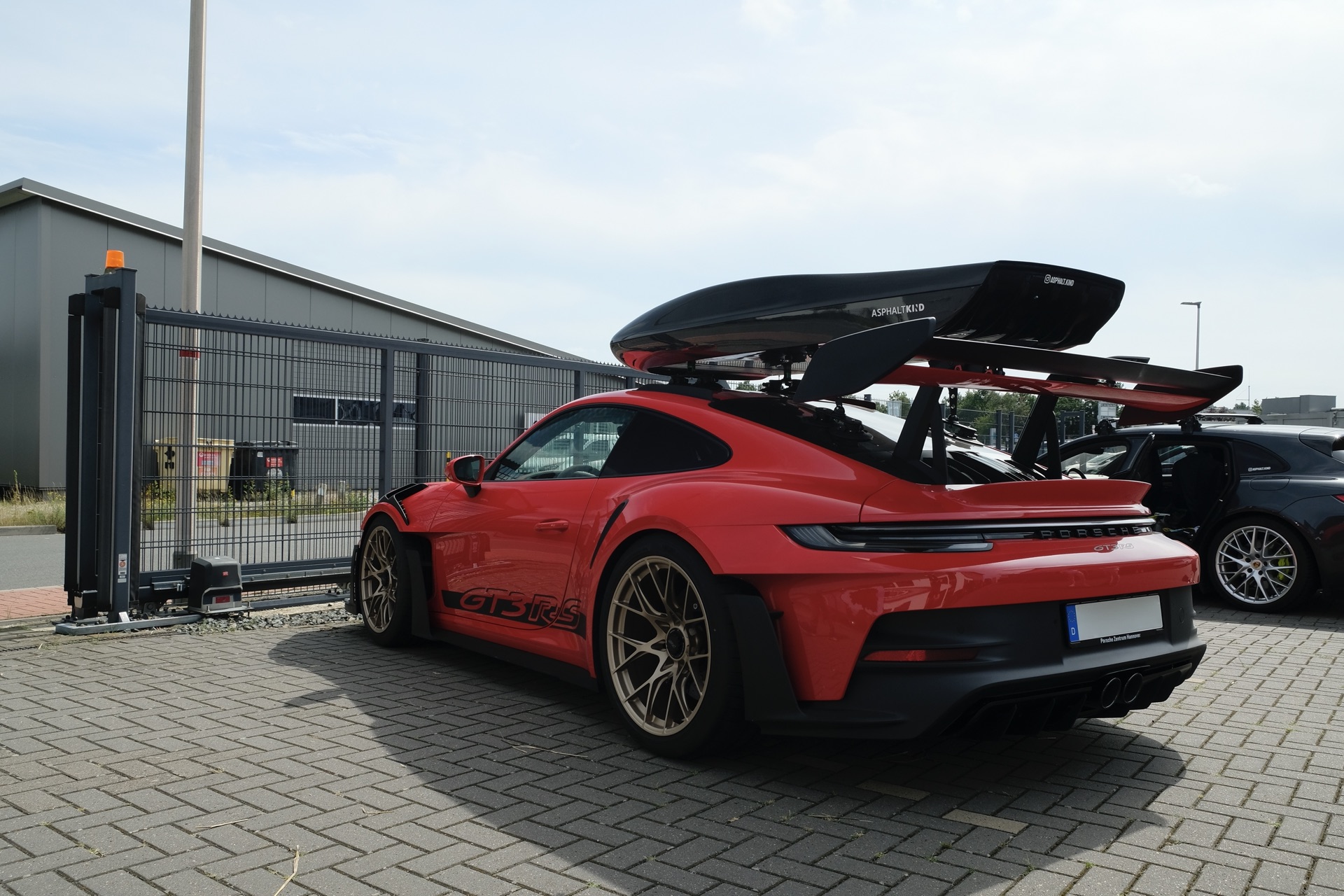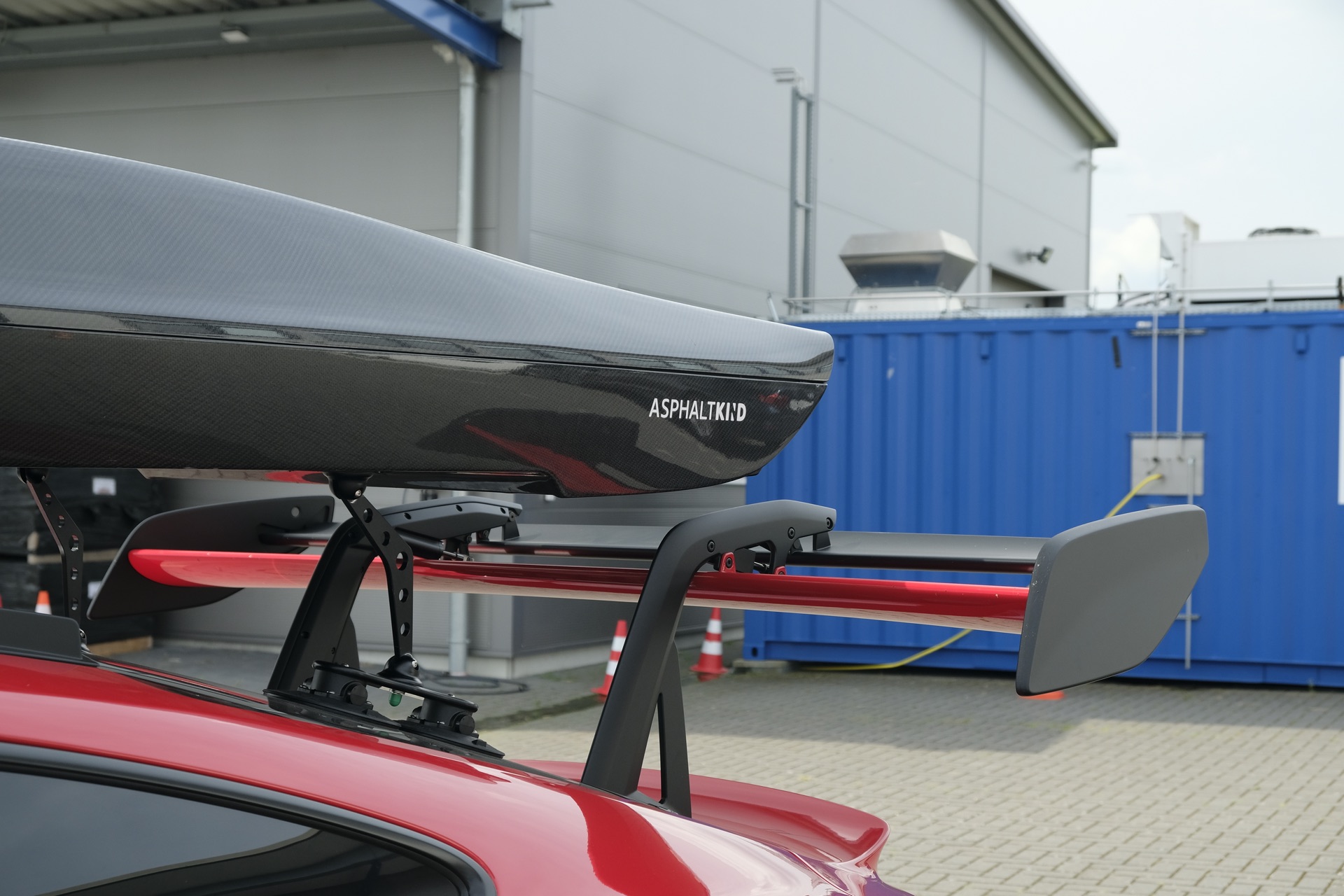The roof box, aka a cargo carrier, has made a triumphant expansion in the last number of years. Once reserved for SUV-driving vacationers, it has become a regular piece of kit for many automotive enthusiasts. I have never before seen as many boxes mounted atop of hot hatches, sports cars and even exotics. The roof box manufacturers must be pleased with their newly found customer base. But, every time I see one on top of a special car, I can’t help but wonder…. Is it simply a cosmetic accessory or is there an actual need for it? What the heck do you have in there anyway?
Without doubt, some drivers have added a roof box just for the sheer cool-factor and have no real use for the thing. Similar to the guy who outfits his Toyota 4Runner complete with petrol containers and a shovel mounted to the roof rack, never to venture off road. I have to admit though, there is something oddly attractive about the contrast of combining a utilitarian device such as a roof box and a sports/exotic car. The first time I remember observing this intriguing mix was nearly a decade ago when professional free-skier and social media personality, Jon Olsson affixed one to his snow camo, 800 HP Lamborghini Huracan. He has also utilized roof boxes on his Gallardo, Audi R8 as well as his RS6. But for Mr. Olsson, not only do his roof boxes look the business, they are also functional, allowing him to haul his gear to the mountains with ease.
Despite my tongue and cheek comment about what is being stored in these boxes, there is, in many cases, a purpose for them. Whether you are transporting sporting equipment or simply need the extra storage space while travelling, the roof box is a welcome addition. What is interesting to me, is the types of vehicles they are now being found upon. I believe that a shift in the mentality of many car enthusiasts has contributed to the current roof box popularity. More and more owners are getting out and enjoying their specialty cars in all types of environments and weather conditions. Don’t get me wrong, there are still owners out there polishing their cars with a diaper and driving them only on the nicest of days. However, many people are now taking the opposite approach and driving their cars as often as possible, proudly stacking up the miles.
Anyone remember Porsche’s media campaign from around ten years ago with the tagline “Porsche Everyday”? One television advertisement featured several Porsche models and suggested that they could be used on a daily basis in all types of situations. No, I am not referring to the Cayenne, Macan or Panamera. The commercial featured a yellow Porsche 911 Turbo picking the kids up from school, complete with the cheeky caption, “SCHOOL BUS”. The same ad also suggested that a Cayman could be used similarly to a pickup truck, showing it parked at a home improvement store while a man loads materials into the front trunk. This savvy marketing strategy aimed to convince potential buyers that what was once thought of as an impractical second or third car, could in fact be the only car you actually need and you could enjoy driving these incredible machines daily.
Many people (example: me) have tried to convince their significant other that a new sports car could do everything their neighbor’s Subaru Outback does. However, in reality, storage space is not high on the priority list of those who are designing our favorite cars. If you intend to transport anything of substance it is likely going to be a challenge in your dream car, especially if it is an Italian two-seater or equivalent.
This is where the roof box can add that much needed utility. They are available in a multitude of sizes and configurations. Boxes marketed as “Alpine” models indicate they have been designed predominantly with the transportation of skis and/or snowboards in mind. They are typically lower in profile and the sleekest in design (they look fabulous by the way). Alpine models are not as practical as the “general-duty” boxes which are usually taller and wider in size. There are several well-known and trusted manufacturers (Thule, Yakima, INNO) and many lesser known brands in the marketplace. Boxes range in price from just several hundred Euro to 1630 Euro for the high-end Thule Vector M box, which has a streamlined design and is equipped with a felt-lined base and led interior lighting.

For those that demand the best in technology, materials and place them in the best possible position to one-up their roof box-toting friends, ASPHALTKIND is best suited. ASPHALTKIND is a German manufacturer that has created a series of roof boxes that are as beautiful as the cars they are designed for. Nils Freyberg, founder and managing director at ASPHALTKIND states that his goal was to develop the perfect roof box. Their boxes are constructed with either Carbon Fiber or Crop Fiber, a newer CO2 reduced, naturally sourced material (think Brown carbon fiber). Nils states that the boxes are extremely lightweight and strong and also feature electric locking systems. ASPHALTKIND boxes start at 8490 Euro and can be found at asphaltkind.de.
Some OEM manufacturers like Audi and Porsche also offer their own branded boxes and roof transport systems (roof racks). Porsche recently introduced a high performance roof box that has been tested at speeds up to 200 km/hr. The OEM roof racks (which the boxes attached to) are often a safe choice if available for your particular vehicle. They are designed to flow with the roof line of the car as opposed to a generic rack that is intended to fit a number of different vehicles. As an example, using a generic roof rack system on a car like the Porsche 911 with a sloped roof, will often result in the box being mounted with the front considerably higher than the rear. This hampers aerodynamics, increases wind noise and is unsightly. Non-OEM racks will work for some vehicles/scenarios but this must be considered when configuring a roof transport system.

Roof boxes, like all things in the automotive world are also being modified to suit the individual. While conducting research for this story, I came across several users on social media that have lowered the rails of their roof racks to allow the roof box to sit closer to the top of the vehicle. Just as lowering a car gives it a more purposeful, appealing stance, lowering the roof box can add to the overall aesthetic as well. Another notable modification includes mounting a roof box to a car that was never intended to carry one. Roni Collin, a well-known Finnish car enthusiast and social media creator has fabricated a quick-release mount system to accommodate his Thule XT Motion roof box on his Porsche 992 GT3 RS. According to Roni, the new GT3 RS poses challenges to mount a carrier as a traditional rack cannot be used due to the lightweight, thin roof. His suction carrier mounts the box further back to accommodate. Roni is intending to produce a small amount of these mounts for purchase. He can be found on Instagram @ronicollin.
Roof boxes are a true game changer and allow drivers to use their cars in ways that were not common a decade ago. I could definitely picture myself on an extended vacation, travelling across the country with everything I need, stored safely in the box while I tackle the mountain passes. A best of both worlds situation.
In the coming year, we will be replacing our family-duty Toyota Highlander which has served us well but is now getting a bit long in the tooth. I am thinking a Porsche 911 Carrera 4S equipped with a roof box would be a fantastic replacement. I will be sure to have the box mounted prior to introducing my wife to our new sports car SUV. I think I will go with a general-duty box for the extra interior room in case I need to sleep inside of it for a few days as she gets used to the idea. Now that I think of it, perhaps I should cross-shop roof tents as well.




























